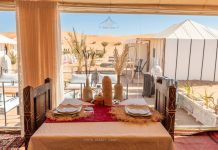Belgrade, the capital of Serbia, is certainly one of the neglected destinations in Europe. To correct that, listed below are some reasons to go to Belgrade and select it to your next city break.
Guest post by Danielle Koch from The Amazing Traveler.
Belgrade is certainly one of Europe’s oldest cities, with evidence of human settlement dating back to the prehistoric Vinča culture, around 7,000 years ago. The city’s strategic location on the confluence of the Sava and Danube rivers made it a very important military and trading post throughout history.
The Celts first established a settlement here within the 4th century BC, naming it Singidūn. Later, it became a Roman city often known as Singidunum. Over the centuries, Belgrade saw many rulers and empires, including the Byzantine Empire, the Bulgarian Empire, and the Kingdom of Hungary.
In the medieval era, the town became a major Serbian stronghold until it fell to the Ottoman Empire within the sixteenth century. This period introduced many architectural and cultural changes, still evident in the town’s landscape. After centuries of Ottoman rule, Belgrade became the capital of Serbia within the nineteenth century, after the Serbian Revolution.
The twentieth century was tumultuous for Belgrade, with each World Wars leaving their marks. Despite this, the town rebuilt and evolved, retaining its historical significance and cultural diversity. Today, Belgrade is Serbia’s capital and a hub of culture, history, and modern urban life, and listed below are the the explanation why it’s value visiting.
Unique Mix of Eastern and Western Cultures
Unlike other European capitals, Belgrade’s unique position on the confluence of the Danube and Sava rivers has made it a crossroads of Eastern and Western cultures.
In Belgrade, you’ll see this mix in every single place. The architecture shows each the Ottoman influence and European styles side by side. Walking around, you’ll find old buildings and churches next to more modern ones, all telling the story of the town’s past.
What is special about Belgrade is how the town kept its history alive while still moving forward. The Kalemegdan Fortress is an ideal example. This old fortress has seen a variety of history, and now it’s a spot where people go to calm down and revel in the views of the rivers.
Cultural Events
Belgrade in winter becomes a gathering place for young people from throughout former Yugoslavia. The city hosts quite a lot of cultural events during this season.
In October, the Book Fair attracts readers and writers, making a space for literary exchange. The Festival of Healthy Living and Healthy Food in November offers insights into wellness and nutrition.
Ulica Otvorenog Srca in January is an enormous, festive event that happens every New Year’s Day. It began way back with actors serving guests in a tavern, and now it’s an enormous deal in the town. The celebration includes music, theater, and fun activities for everybody.
It’s held in several places across Belgrade, attracting 1000’s of individuals. There are performances by choirs, orchestras, and artists.
Reasons to Visit Belgrade: Nightlife
Just like Berlin in 2000, Belgrade today is a serious center for nightlife. Floating nightclubs on the Sava and Danube rivers are legendary amongst party-goers.
In Skadarlija, you’ll be able to experience the normal Serbian atmosphere with folk music in kafanas.
For techno and trance enthusiasts, Beton Hala is the place to be, hosting quite a few clubs pulsating with these genres.
If live pop and rock are more your style, head over to Ada Ciganlija, where you’ll discover a vigorous scene perfect to your music preferences.
Interesting Architecture
Belgrade’s architectural scene is diverse with landmarks spanning many centuries.
The Belgrade Fortress is an emblem of the town’s past. This fortress has seen many battles and changes over the centuries, and its architecture reflects that. It’s like walking through a history book!
Then there’s the Church of Saint Sava, certainly one of the most important Orthodox churches on the planet. Its grandeur and wonder are awe-inspiring.
Belgrade also has its share of unique, modern buildings. The Western City Gate, known locally as Genex Tower, is one such example.

Delicious Serbian Cuisine
Serbian cuisine often ranks just behind the French or Italian on top food lists worldwide. It’s a mix of Mediterranean zest, with hints of Hungarian, Turkish, and Austrian influences.
Ćevapi, for example, is a must-try. These small, grilled minced meat sausages, crafted from pork, beef, or lamb, are a street food favorite. They are typically served with flatbread, fresh onions, and a savory sauce, creating a straightforward yet unforgettable taste.
Another notable dish is Sarma, where minced meat and rice are rolled in cabbage or vine leaves after which slow-cooked, making a comforting and flavorful meal.
Affordability
Belgrade is certainly one of Europe’s most budget-friendly destinations. The cost of living and traveling in the town is comparatively low in comparison with other European capitals. This affordability applies to varied facets, from accommodation to dining and even entertainment.
Accommodation options in Belgrade cater to all budgets, with a variety of hostels, budget hotels, and inexpensive rental apartments. Even in the town center, the costs are generally lower than in lots of Western European cities.
When it involves dining, Belgrade offers a plethora of options that won’t cost you an arm and a leg. Traditional Serbian eateries, local bakeries, and street food stalls have delicious meals at very reasonable prices.
The city can be known for its café culture, where you’ll be able to enjoy a coffee or a snack without spending rather a lot.
Public transportation in Belgrade is efficient and cost-effective. Tickets for buses, trams, and trolleys are inexpensive, making it easy to explore the town on a budget.
Moreover, a lot of Belgrade’s attractions, just like the historic Kalemegdan Fortress, Gardoš, Ada Ciganlija, and Knez Mihailova Street, are free to go to.
Day Trips From Belgrade
With its strategic location in Southeast Europe, Belgrade is a wonderful start line for exploring the region. It sits near several other countries, so you’ll be able to go on day trips from Belgrade to cities like Timisoara, Budapest, and Zagreb.
Timisoara in Romania, a 3-hour drive from Belgrade, is understood for its beautiful architecture and historical significance as the primary European city with electric streetlights.
Budapest, Hungary, reachable in about 4 hours by train or automobile, has stunning architecture, a wealthy history, and famous thermal baths.
Zagreb, the capital of Croatia, about 4 hours from Belgrade, is a city wealthy in museums, green spaces, and historic sites.
There are also appealing destinations inside Serbia, like Novi Sad, known for its Petrovaradin Fortress, and the EXIT music festival, just an hour’s drive away.
Novi Sad contrasts Belgrade’s energy with a more relaxed atmosphere.
Another nearby place is Topola, an hour away, famous for its wineries and the historical Oplenac complex.
Riverside Charm
With its city center situated on the confluence of two major rivers, the Danube and the Sava, Belgrade is exclusive in Europe and doubtless on the planet.
The Belgrade Waterfront area along the Sava River is a recent a part of the town, combining living spaces, shops, and places to hang around. It’s crammed with walkways, parks, and modern buildings, so it’s an important place for a walk, a meal, or simply to see the river views.
War Island, on the joining of the Danube and Sava, is a green spot right in the midst of the town. It’s protected for its nature and birds, and what’s interesting in regards to the island is that it’s growing. It’s getting larger and larger every 12 months.
Taking a cruise on the Danube and Sava is a cool strategy to see Belgrade from a special angle. You can see each old and recent parts of the town from the water, providing you with a feel for why this spot by the rivers is so special.

Ada Ciganlija
Although Belgrade isn’t on the coast, Ada Ciganlija, a river island turned peninsula within the Sava River, brings the beach experience right to the town’s heart. It’s certainly one of the most important urban beaches in Europe, if not the most important.
During the summer, Ada Ciganlija draws an incredible number of holiday makers – about 100,000 people each day, and the numbers can soar to over 300,000 on weekends.
The beach at Ada Ciganlija has every little thing you may want for a day by the water. There are beach bars where you’ll be able to grab a drink, calm down, and revel in the sun.
For those in search of more energetic pursuits, the world is well-known for its big selection of water sports. You can try every little thing from swimming and rowing to more adrenaline-packed activities like water skiing.
In this area, there are also trails for walking and cycling, picnic spots, and even facilities for other sports like golf and tennis. There are also small trains that may take you around the world.
Warm Hospitality
According to a project by Harvard University called Project Implicit, Serbia is the least racist country in Europe.
In Serbia, guests are sometimes greeted with open arms and treated like family. This hospitality is visible in on a regular basis interactions, social gatherings, and particularly in traditional settings.
Visitors to Serbia often speak of the heat and friendliness of the locals, who’re keen to share their culture, cuisine, and stories.
This welcoming atmosphere extends beyond personal interactions. Serbia’s diverse history and cultural influences have fostered a society that’s generally tolerant and accepting of various cultures and backgrounds.
Escape the ordinary and discover the extraordinary! From bustling cities to serene landscapes, every journey begins with a single step—let us guide yours. Enjoy curated itineraries, hidden gems, and hassle-free bookings designed for explorers at heart. Whether it's a weekend getaway or a globe-trotting adventure, your Next unforgettable experience is just a click away.










